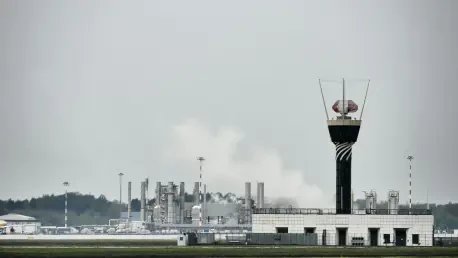The aviation industry’s readiness to confront future threats has become an increasingly urgent topic as emerging risks threaten to disrupt stability. A comprehensive research report by Willis surveyed 130 senior aviation representatives, revealing stark insights into the industry’s level of preparedness. The findings point to a concerning gap between the recognition of these risks and the readiness of strategic frameworks to address them effectively. Leading this discourse is the insufficient confidence among aviation executives about their company’s capabilities in tackling current and future threats. This essay delves into the readiness of the industry to adapt.
Understanding Emerging Risks
Defining and Prioritizing Emerging Risks
The aviation sector faces a pivotal challenge in identifying and prioritizing emerging risks, with many executives struggling to navigate this complex landscape. The report highlighted the obscurity surrounding the definition of emerging risks, with about 80-90% of key decision-makers expressing a lack of clarity on the term. This ambiguity extends to the prioritization process, with nearly half of those surveyed unable to enumerate their top five emerging risks. The survey underscores a critical issue: the need for a shared understanding and clarity within organizations to devise effective strategies to tackle these challenges.
The categorization of emerging risks falls into four significant groups: climate transition, geopolitical and economic risks, cyber risks, and artificial intelligence (AI). Each category poses unique obstacles and demands distinct strategic responses. Yet, only 30% of the respondents felt that their current strategies were adept at navigating these evolving challenges. The industry appears to be grappling with a misalignment between known concerns and proactive planning. As these threats intensify, a robust approach to risk management becomes indispensable. The importance of comprehensive identification and prioritization moves beyond theoretical exercises into practical necessities, urging aviation leaders to foster risk-awareness and adaptability.
Climate Transition and Its Implications
Climate change is a critical emerging risk prominently featured in the report, rising as a top concern among almost 29% of industry stakeholders. Its effects are profoundly felt by fixed-asset operators, including airports and fuel suppliers, who are more vulnerable to climate-related disruptions. The challenges associated with climate transition demand immediate and sustained attention, underscoring a fundamental shift in how the industry perceives both current and future operations. The report suggests that over half of the industry representatives anticipated environmental threats to remain significant over the next decade.
The implications of climate change on the aviation industry are multifaceted, demanding innovative solutions and strategic transformations. Operators need to integrate environmentally sustainable practices while managing the financial and operational impacts of climate-related events. This includes adapting infrastructure to withstand extreme weather, investing in sustainable aviation fuels, and pivoting towards technologies that reduce carbon footprints. The ability of industry stakeholders to address these evolving climatic challenges will hinge on collaborative efforts to foster resilience. As the impact of climate change continues to broaden, its potential to redefine operational standards and strategic paradigms becomes increasingly evident.
Addressing Geopolitical and Cyber Challenges
The Network of Geopolitical and Economic Risks
Geopolitical and economic risks permeate the aviation landscape, shaping industry decisions and strategic approaches throughout. Concerns about financial instability, geopolitical tensions, and government policy further influence the industry’s risk framework, elucidating the interconnectedness of these threats. Surveyed executives acknowledged this complexity, noting how these multifarious factors intensify each other’s effects, creating a daunting web of challenges. The ability to maneuver through these uncertain terrains requires a broadened outlook that embraces uncertainty and flexibility.
Additionally, the industry’s lack of comprehensive economic risk transfer solutions underscores a potential area for innovation and improvement. As these geopolitical challenges continue to evolve, developing robust risk management products is crucial for enhancing industry resilience. Executives must focus on collaboration both within and outside the aviation sector to develop holistic strategies. By addressing these risks collectively, there is potential to enhance economic stability and sustain growth. Navigating these turbulent waters will require industry leaders to foster partnerships and embrace a dynamic, interdependent approach to risk mitigation.
Cybersecurity and Technological Evolution
Cybersecurity emerges as a crucial concern, notably recognized by 11% of respondents as one of the most pressing issues today. This challenge persists in five- and ten-year risk projections, with aviation companies, as custodians of critical infrastructure, remaining prime targets for cybercrime. The evolving technological landscape introduces vulnerabilities while simultaneously offering solutions, exemplifying the duality of cyber risks. The convergence of cybersecurity and AI amplifies the intricacy of this challenge, presenting new avenues for both mitigation and risk exposure.
The report highlights the necessity for enhanced cybersecurity protocols to safeguard the industry’s assets and data from breaches and threats. Aviation operators are urged to expand their focus on cybersecurity, adopting an anticipatory stance rather than a reactive one. The integration of advanced technologies like AI offers a potential buffer but must be approached cautiously to avoid exacerbating vulnerabilities. A comprehensive strategy focusing on strengthening cybersecurity infrastructures while leveraging technological advancements is paramount. The path forward entails cultivating an agile, insights-driven approach to defend against an ever-evolving cyber threat landscape.
Charting a Course Toward Resilience
Embracing AI and Technological Advancement
Artificial Intelligence (AI) presents a nuanced risk and opportunity landscape in aviation, identified by 36% of respondents as an immediate concern, though not prevalent in the long-term top five risk outlook. The dual nature of AI—whether seen as a catalyst for operational efficiency or a risk factor—requires strategic discernment. The challenge lies in balancing innovation and risk, navigating the potential for transformative change against caution towards unforeseen implications.
The aviation industry finds itself at a crossroads, where traditional practices intersect with cutting-edge technology. The collective nature of the industry might facilitate faster adoption of AI-driven solutions, potentially reducing risk across sectors. Collaboration and shared investment in AI technologies could drive industry-wide benefits, rather than disproportionately advantaging individual entities. Aviation operators need to initiate dialogues on collective adaptation strategies, ensuring an equitable distribution of technological advancements. This approach promises to propel the industry into a new era of enhanced performance, efficiency, and resilience.
Reevaluating Risk Management Strategies
The aviation industry is increasingly under pressure to brace for future threats as emerging risks threaten its stability. A comprehensive study conducted by Willis surveyed 130 senior aviation officials, exposing significant insights into the industry’s preparedness. Key takeaway: there’s a noticeable gap between acknowledging these risks and having effective strategic frameworks to address them. At the forefront of this discussion is the uncertainty among aviation leaders about their companies’ abilities to handle present and upcoming threats. Their lack of confidence highlights a fundamental issue within the industry—the need for robust strategic planning and adaptable risk management. This essay explores the industry’s preparedness for evolving challenges, emphasizing the urgent requirement for improved strategies that ensure greater resilience and adaptability. As risks evolve, the aviation sector must enhance its frameworks to protect against disruptions, ensuring ongoing stability in an unpredictable future.









